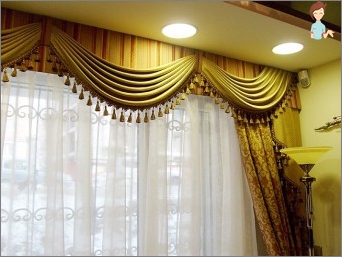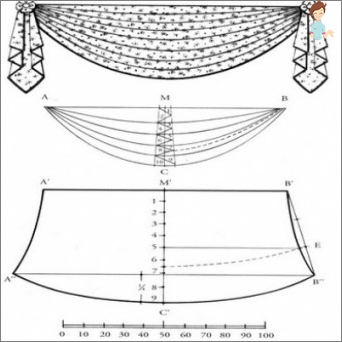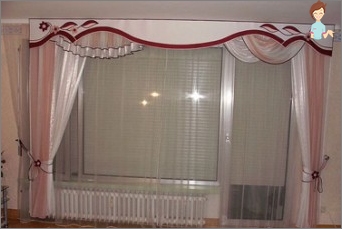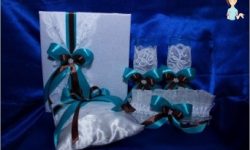We sew lambrequins do it yourself
Windows decorations are an important component of the design of the room. Knowing how to sew lambrequins, there will never be problems with the finish. Now you will learn to do it with your own hands
In the design of the premises, the curtains play an important role and to some extent they ask the general topic of interior. Today you can find options with various decorations, among which lambrequins are particularly popular. With their help, the appearance and the overall concept of the interior will be completed and original.
There are a huge selection of such parts for curtains (see. photo below), but the price is high. In addition, it is quite difficult to choose the option suitable for your own interior. In this case, there is a solution – we sew a lambrene with your own hands. Thanks to a simple master classes, you will probably manage to do this decoration at home.
How to sew a lambrequen swag?
 Elegant decoration, considered in this master class, is ideal for high and narrow windows. This option is most often used in the classic interior.
Elegant decoration, considered in this master class, is ideal for high and narrow windows. This option is most often used in the classic interior.
It is worth noting that the Svag looks great on cascading curtains, as well as on the types of Jabs.
Necessary materials to sew a lambrequin:
- Drapery matter, the width of which should be 137 cm;
- Lining matter, the width is the same;
- Flax ribbon, the width of which should be 2.5 cm;
- Tape for finishing, but it is at will;
- Different decor elements;
- Thread of contrasting color;
- Kraft paper.
To sew the lambrequen was simply, it is recommended to initially make certain measurements:
Switch width (1) – means the length of the mounting board. To find out, you need to measure the length of the cornice.
Swag Height (2) – Fold Depth. To measure it, you need to find the middle of the width (1) and go down to the bottom of the fold.
Arc length (3) – means the length of the prompt. To measure it is necessary from the start of the width (1), go back to the height in and again, but already at the end (1). Use to measure at home the lace.
Cascade length (4) – means at what level the side cascades will fall. It all depends on personal preferences. The cascade can reach the floor, and maybe before the middle of the curtains. There is a classic option, according to which the length of the cascade is three heights of the Swag.
Cascade width (5) – To determine if there is a formula: 1 / 3x (1) + mounting board width.
Building pattern
Without this point, it is impossible to do without this, because otherwise it will not be able to get the perfect lambrene. Take a large sheet of paper or special traction intended for patterns. From above, draw a horizontal line and put the point a point on it. Do it all on the left side of the sheet.
All vertical segments set down down. To properly build a scheme, use the following formulas:
- A-B = 2x (2) +12.7. Swipe the vertical line down and at the point in the horizontal line;
- A-C = 1 / 4x (1). The resulting value set aside on the left side of the point A. The same length refuse to the right and put the point D;
- In e = 0,5x (3). The resulting value set aside on the left side of the point in. The same length refuse to the right and put the point F;
- E-G = 0.5x (2). From point e, raise the vertical line up and set aside the value obtained. Repeat too, but only postpone the segment F-H. As a result, a GHFE rectangle should turn out. In it, tighten the arc from the point G to in and to. Also spend the G-C and H-D line;
- Last point i to get it Find the middle of the segment A-in.
 In order to properly sew the lambrequins at home, it is necessary to determine where the share thread will undergo.
In order to properly sew the lambrequins at home, it is necessary to determine where the share thread will undergo.
To do this, draw a small square in such a way that one side coincides with the segment A-in. Through the center of this square, draw two diagonals, one of them will undergo a filament.
Now you need to make the pattern of the cascade. To do this, on the first vertical line, where the point A is located, put the point J, on the right side in the second half of the sheet.
Before sewing a lambrequin, as in the photo, make a pattern, according to the following measurements:
- J-k = (4) +2.5. Swipe the vertical line down and measure the required length;
- J-L = C-D. The segment must be postponed on the left side of the point j;
- L-M = A-I. Spend the vertical line and measure the required value. From point M, spend the horizontal line to the intersection with the segment J-K. Spend a line M-K;
- J-N = width of the mounting board. From the point n, lower the vertical line, and from the point to spend horizontal to the right. In the place where they crossed, put the point about.
The equity thread will pass along the line parallel J-K. Cutting out the pattern, do not forget about the allowances for the seams.
How to make a swag?
It is light waves on the lambrene make this item beautiful and elegant. Thanks to the assemblies, visual decoration looks volume. Transfer the pattern to the fabric. Matter fold in half and measure the fold at a distance of 12.5 cm from the top.
The latter wave will be at a distance of 10 cm from Niza. Other folds mark at an equal distance (no less than 10 and no more than 15 cm) between these points. Make the appropriate marks on each side.
Now do it yourself make the pattern of the cascade. Folds worth forming up the top edge. The first fold should be done at a distance of 12.5 cm from point L. The segment between the first label and the point J is divided into the same parts of a width of 10 to 15 cm. The patterns made will help to figure out how to sew a lambrequin.
To frame one window, you must have a Swag, lining and 4 cascades. Using all calculations, you can measure the values for windows in your home, which will allow you to purchase the right amount of matter. Another important aspect – if you use a fabric with a pattern and drapering, then consider that it should turn out to be symmetrical, especially considering the folds.
Instructions, how to properly sew a lambrequin:
- The top of the wague and the lining are subjected to, taking into account the allowance on the seam, and lay it;
- Face to each other fold two parts and susht them, but leave one angle unenvisory. Remove them and find the edge of the secret seam;
- Slide the allowance and thoroughly sharpen them. Also repeat with a cascade;
- Secure the folds of the folds;
It remains right to attach lambrequin on the mounting board.
We sew tough lambrequins
This type of decoration looks original in any room. There are many different options, we suggest to consider on the most elegant of them. So, sew curtains with openwork lambrequin. It is used for its manufacture using a bandage – adhesive material that allows you to create a tough basis. Make an openwork hard lambrequin not easy, but the result is worth.
To begin with, consider the features of rigid lambrequins:
- To give the volume of such a lambrequen, you can use syntheps, cotton wool and t.NS.;
- Forms can be completely different. The facial part most often has the form of the arch or repeats the bends of the window;
- The lower edge can be both direct and figured;
- You can use ropes, fringe and other decor options to finish the edge.
Necessary materials:
- Bando;
- Matter for the base;
- Lining;
- Lace or braid for decoration.
Openwork lambrequin can decorate the corners of the curtains, but you can also make a figure in the center of the window, which will look no less original. Take paper and draw the desired pattern on it. It is important that the openwork lines are not too thin.
 The resulting foundation must be transferred to the bandanda and cut. We sew a lambrequen at home, starting with the overlapping of a bandana from the wrong side of matter. Depending on the material used or simply get it, or it is good to walk on it with iron. Then put the lining and handle on the edge machine.
The resulting foundation must be transferred to the bandanda and cut. We sew a lambrequen at home, starting with the overlapping of a bandana from the wrong side of matter. Depending on the material used or simply get it, or it is good to walk on it with iron. Then put the lining and handle on the edge machine.
To improve the appearance and hide the seam use a cord that can be glued with hot glue. In principle, the openwork lambrequin is ready, it can be filled with a typical basis for rigid lambrequin. To mount it to the eternity in the top sew a velcro, retreating from the edge of a couple of centimeters.
Thanks to the detailed described master class, you should not have problems with the sewing of the lambrequins. Using the considered recommendations, it will be possible to easily deal with other options. A little practice and be sure everyone will certainly succeed.


